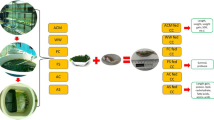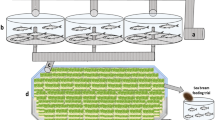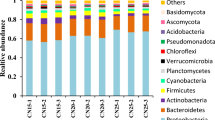Abstract
Organic acids and/or their salts could be used as acidifiers to improve the performance, health, and immunity status of aquatic organisms. Generally, a single acidifier is used as a feed additive but the present study used a multiple acidifiers blend (Latibon®), which is a mixture of formic acid (25.7%), lactic acid (11.5%), and citric acid (7.0%). In the present study, each pond (3 acres) of nine earthen ponds was stocked with 15,000 Nile tilapia (NT; 2.1 ± 0.2 g), 3000 striped mullet (SM; 10.7 ± 1.7 g), and 300 African catfish (AC; 218.0 ± 10.3 g) representing a fish biomass of 10.5–11.5, 10.9–11.2, and 5.4–5.5 kg/acre, respectively. Latibon® was incorporated to a floating diet at levels of 0.0 (control), 1.5, and 3.0 g/kg diet. Fish fed one of the tested diets up to apparent satiation for a period of 20 min thrice a day at 9:00, 12:00, and 16:00 h for 28 weeks. At the end of the feeding period, each pond was drained and fish of each cultured species were collected, counted, and group-weighed. No significant difference was observed in fish survival among the different treatments and its range was 92.1–93.4% for NT, 86.2–87.6% for SM, and 87.3–90.3% for AC. The production of NT, SM, and AC increased significantly as levels of Latibon® increased from 0.0 (828.9, 273.9, and 68.2 kg/acre, respectively) to 3.0 g/kg diet (1204.4, 304.3, and 77.8 kg/acre, respectively). The total fish yield in the control ponds was 1171.0 kg/acre, while it was maximized in ponds fed 3.0 g/kg diet of Latibon® (1586.5 kg/acre). This is because fish consumed more feed with increasing the levels of Latibon® from 0.0 (4614.0 kg feed/pond) to 3.0 g/kg diet (6256.0 kg feed/pond) with insignificant differences in feed conversion ratios per ponds (1.34–1.35). Nile tilapia was the target fish; however, its production percentage to the total fish yield was 75.9%, whereas those of SM and AC were 19.2% and 4.9%, respectively, in ponds received 3.0 g/kg of Latibon®. Additionally, in this treatment, the sale of NT represented 62.8% of the total fish sale, whereas these of SM and AC were 34.1 and 3.1%, respectively. The simple economic analysis revealed that the net profit of ponds received 3.0 g/kg diet of Latibon® increased by 23.3% over that received the control diet. Thus, the present study recommends the incorporating of 3.0 g/kg diet of Latibon® to fish diets.


Similar content being viewed by others
References
Abdel-Tawwab M (2005) Predation efficiency of Nile catfish, Clarias gariepinus (Burchell, 1822) on fry Nile tilapia, Oreochromis niloticus. Turkish J Fish Aquat Sci 5:69–74
Abdel-Tawwab M (2016) Feed supplementation to freshwater fish: experimental approaches. LAP Lambert Academic Publishing, Berlin
Abdel-Tawwab M, Abdelghany AE, Ahmad MH (2007) Effect of diet supplementation on water quality, phytoplankton community structure, and the growth of Nile tilapia, Oreochromis niloticus (L.), common carp, Cyprinus carpio L., and silver carp, Hypophthalmichthys molitrix V. polycultured in fertilized earthen ponds. J Appl Aquac 19:1–24
Abu Elala NMA, Ragaa NM (2015) Eubiotic effect of a dietary acidifier (potassium diformate) on the health status of cultured Oreochromis niloticus. J Adv Res 6:621–629
Boyd CE, Tucker CS (2012) Pond aquaculture water quality management. Springer Science & Business Media, Kluwer Academic Publishers, Dordrecht
Dickson M, Nasr-Allah A, Kenawy D, Kruijssen F (2016) Increasing fish farm profitability through aquaculture best management practice training in Egypt. Aquaculture 465:172–178
Dytham C (2011) Choosing and using statistics: a biologist’s guide. Blackwell Science Ltd, London
El Gamal AA, Abdel-Halim AMM, Abdel-Razek E, Solomon A (1998) Biological studies on the Nile perch Lates niloticus (L) and African catfish Clarias gariepinus (T.) in reference to their food habits and predation pattern in culture ponds. Egypt J Agric Res 76:335–349
El Gayar OF (2003) Aquaculture in Egypt and issues for sustainable development. Aquacult Econ Manag 7(1–2):137–154
El Naggar G (2008) The African catfish Clarias gariepinus: a perspective on its role and potential in Egyptian aquaculture. In: Proceedings of a Workshop on the Development of a Genetic Improvement Program for African Catfish, Clarias gariepinus. Accra, Ghana, 5–9 November 2007. p 15
Hanson T, Sites D (2012) 2011 U.S. Catfish Database. Information Report 2012–01. Michigan State University Department of Agricultural, Food, and Resource Economies, East Lansing
Hebicha HA, El Naggar GO, Nasr-Allah AM (2013) Production economics of Nile tilapia (Oreochromis niloticus) pond culture in El-Fayum Governorate, Egypt. J Appl Aquac 25:227–238
Ibrahim N, El Naggar G (2010) Water quality, fish production and economics of Nile tilapia, Oreochromis niloticus, and African catfish, Clarias gariepinus, monoculture and polycultures. J World Aquacult Soc 41:574–582
Kemigabo C, Abdel-Tawwab M, Lazaro JW, Sikawa D, Masembe C (2018) Combined effect of dietary protein and phytase levels on growth performance, feed utilization, and nutrients digestibility of African catfish, Clarias gariepinus (B.), reared in earthen ponds. J Appl Aquac 30:211–226
Khajepour F, Hosseini SA (2012) Citric acid improves growth performance and phosphorus digestibility in Beluga (Huso huso) fed diets where soybean meal partly replaced fish meal. Anim Feed Sci Technol 171:68–73
Koh C-B, Romano N, Zahrah AS, Ng W-K (2016) Effects of a dietary organic acids blend and oxytetracycline on the growth, nutrient utilization and total cultivable gut microbiota of the red hybrid tilapia, Oreochromis sp., and resistance to Streptococcus agalactiae. Aquac Res 47:357–369
Kumar P, Jain KK, Sardar P, Sahu NP, Guptal S (2017) Dietary supplementation of acidifier: effect on growth performance and haemato-biochemical parameters in the diet of Cirrhinus mrigala juvenile. Aquac Int 25:2101–2116
Li JS, Li JL, Wu TT (2009) Effects of non-starch polysaccharides enzyme, phytase and citric acid on activities of endogenous digestive enzymes of tilapia (Oreochromis niloticus x Oreochromis aureus). Aquac Nutr 15:415–420
Lin Y-H, Cheng M-Y (2017) Effects of dietary organic acid supplementation on the growth, nutrient digestibility and intestinal histology of the giant grouper Epinephelus lanceolatus fed a diet with soybean meal. Aquaculture 469:106–111
Lückstädt C (2008a) The use of acidifiers in fish nutrition. CAB Rev Perspect Agric Vet Sci Nutr Nat Resour 3:1–8
Lückstädt C (2008b) Effect of organic acid containing additives in worldwide aquaculture--sustainable production the non-antibiotic way. In: Lückstädt C (ed) Acidifiers in animal nutrition: a guide for feed preservation and acidification to promote animal performance. Nottingham University Press, Nottingham, pp 71–79
Milstein A (1992) Ecological aspects of fish species interactions in polyculture ponds. Hydrobiologia 231:177–186
Morken T, Kraugerud OF, Barrows FT, Sørensen M, Storebakken T, Øverland M (2011) Sodium diformate and extrusion temperature affect nutrient digestibility and physical quality of diets with fish meal and barley protein concentrate for rainbow trout (Oncorhynchus mykiss). Aquaculture 317:138–145
Ng W-K, Koh C-B, Sudesh K, Siti-Zahrah A (2009) Effects of dietary organic acids on growth, nutrient digestibility and gut microflora of red hybrid tilapia, Oreochromis sp., and subsequent survival during a challenge test with Streptococcus agalactiae. Aquac Res 40:1490–1500
Ng W-K, Koh C-B, Teoh C-Y, Romano N (2015) Farm-raised tiger shrimp, Penaeus monodon, fed commercial feeds with added organic acids showed enhanced nutrient utilization, immune response and resistance to Vibrio harveyi challenge. Aquaculture 449:69–77
Rad F, Kurt G, Bozaouglu AS (2004) Effects of spatially localized and dispersed patterns of feed distribution on the growth, size dispersion and feed conversion ratio of the African catfish (Clarias gariepinus). Turkish J Vet Anim Sci 28:851–856
Reda RM, Mahmoud R, Selim KM, El-Araby IE (2016) Effects of dietary acidifiers on growth, hematology, immune response and disease resistance of Nile tilapia, Oreochromis niloticus. Fish Shellfish Immunol 50:255–262
Saei MM, Beiranvand K, Taee HM, Nekoubin H (2016) Effects of different levels of bioacid ultra on growth performance, survival, hematologichal and biochemical parameters of fingerlings rainbow trout (Oncorhynchus mykiss). J Aquac Res Dev 7:2. https://doi.org/10.4172/2155-9546.1000455
Shaalan M, El-Mahdy M, Saleh M, El-Matbouli M (2018) Aquaculture in Egypt: insights on the current trends and future perspectives for sustainable development. Rev Fish Sci Aquac 26:99–110
Sharma KR, Leung P, Chen H, Peterson A (1999) Economic efficiency and optimum stocking densities in fish polyculture: an application of data envelopment analysis (DEA) to Chinese fish farms. Aquaculture 180:207–221
Silva BC, Nolasco-Soria H, Magallón-Barajas F, Civera-Cerecedo R, Casillas-Hernández R, Seiffert W (2016a) Improved digestion and initial performance of white leg shrimp using organic salt supplements. Aquac Nutr 22:997–1005
Silva BC, Vieira F do N, Mouriño JLP, Bolivar N, Seiffert WQ (2016b) Butyrate and propionate improve the growth performance of Litopenaeus vannamei. Aquac Res 47:612–623
Soliman NF, Yacout DMM (2016) Aquaculture in Egypt: status, constraints and potentials. Aquacult Int 24:1201–1227
Soltan MA, Hassaan MS, Meshrf RN (2017) Response of Nile tilapia (Oreochromis niloticus) to diet acidification: effect on growth performance and feed utilization. J Appl Aquac 29:207–219
Sugiura SH, Dong FM, Hardy RW (1998) Effects of dietary supplements on the availability of minerals in fish meal; preliminary observations. Aquaculture 160:283–303
Tina FW (2008) Optimization of stocking ratio of silver carp and catla in mola-carp-tilapia polyculture system. MS dissertation, Department of Fisheries Management, Bangladesh Agricultural University, Mymensingh, Bangladesh
Tran-Ngoc KT, Huynh ST, Sendão J, Nguyen TH, Roem AJ, Verreth JAJ, Schrama JW (2018) Environmental conditions alter the effect of organic acid salts on digestibility and intestinal morphology in Nile tilapia (Oreochromis niloticus). Aquac Nutr. https://doi.org/10.1111/anu.12837
Vielma J, Lall SP (1997) Dietary formic acid enhances apparent digestibility of minerals in rainbow trout, Oncorhynchus mykiss (Walbaum). Aquac Nutr 3:265–268
Wood RJ, Serfaty-Lacrosniere C (1992) Gastric acidity, atrophic gastritis, and calcium absorption. Nutr Rev 50:33–40
Xie S, Zhang L, Wang D (2003) Effects of several organic acids on the feeding behavior of Tilapia nilotica. J Appl Ichthyol 19:255–257
Funding
This study was funded and supported by the Central Laboratory for Aquaculture Research, Abbassa, Abo-Hammad, Sharqia, Egypt.
Author information
Authors and Affiliations
Corresponding author
Ethics declarations
Conflict of interest
The authors declare that they have no conflict of interest.
Ethical approval
All applicable international, national, and/or institutional guidelines for the care and use of fishes were followed by the authors.
Rights and permissions
About this article
Cite this article
Abdel-Tawwab, M., Khattaby, AR.A. & Monier, M.N. Dietary acidifiers blend enhanced the production of Nile tilapia (Oreochromis niloticus), striped mullet (Mugil cephalus), and African catfish (Clarias gariepinus) polycultured in earthen ponds. Aquacult Int 27, 369–379 (2019). https://doi.org/10.1007/s10499-018-0329-0
Received:
Accepted:
Published:
Issue Date:
DOI: https://doi.org/10.1007/s10499-018-0329-0




